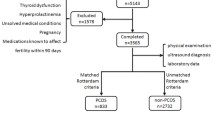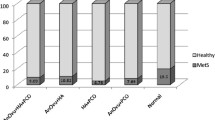Abstract
Purpose
The aim of this study was to estimate the prevalence, to evaluate the characteristics of the metabolic syndrome (MetS) in Greek women with polycystic ovary syndrome (PCOS) and to investigate the correlation of MetS with body mass index (BMI).
Methods
In a prospective controlled study, 230 Greek female patients with PCOS and 155 age-matched healthy controls were enrolled. Diagnosis of PCOS was based on the revised criteria of Rotterdam. Both groups were examined for MetS. Diagnosis of MetS was based on the revised criteria of International Diabetes Federation (IDF).
Results
The prevalence of the MetS was 12.6 %, nearly sevenfold higher than the controls. Elevated fasting plasma glucose (7.0 vs. 1.9 %) and elevated triglycerides (10.4 vs. 3.2 %) were more frequent in the PCOS cohort (p < 0.05). Women with PCOS presented statistically higher BMI in comparison with the controls (p < 0.001). Subsequently, the prevalence of MetS was estimated in three groups: normal, overweight and obese subdivided according to BMI. The latter two groups showed significant differences compared with the healthy controls (24.5 vs. 8.8 %, p = 0.050).
Conclusion
In conclusion, this study showed high prevalence of MetS and increased BMI in Greek PCOS women. In addition, it demonstrated the higher prevalence of MetS in obese PCOS women in comparison with the controls. These results are placing them at increased risk for cardiovascular disease and diabetes in the future and underline the necessity of periodic screening, appropriate diet and exercise program.

Similar content being viewed by others
References
Azziz R, Woods KS, Reyna R, Key TJ, Knochenhauer ES, Yildiz BO (2004) The prevalence and the features of the polycystic ovary syndrome in an unselected population. J Clin Endocrinol Metab 89:245–249
Asuncion M, Calvo RM, San Millán JL, Sancho J, Avila S, Escobar-Morreale HF (2000) A prospective study of the prevalence of the polycystic ovary syndrome in unselected Caucasian women from Spain. J Clin Endocrinol Metab 85:2434–2438
Hart R, Hickey M, Franks S (2004) Definitions, prevalence and symptoms of polycystic ovaries and polycystic ovary syndrome. Best Pract Res Clin Obstet Gynaecol 18:671–683
The Rotterdam ESHRE/ASRM-Sponsored PCOS consensus workshop group (2004) Revised 2003 consensus on diagnostic criteria and long-term health risks related to polycystic ovary syndrome (PCOS). Hum Reprod 19(1):41–47
Ehrmann DA, Barnes RB, Rosenfield RL, Cavaghan MK, Imperial J (1999) Prevalence of impaired glucose tolerance and diabetes in women with to polycystic ovary syndrome. Diabetes Care 22:141–146
Dunaif A (1995) Hyperandrogenic anovulation (PCOS) a unique disorder of the insulin action associated with an increased risk of non-insulin-dependent diabetes mellitus. Am J Med 98:33–39
Legro RS, Kunselman AR, Dodson WC, Dunaif A (1999) Prevalence and predictors of risk for type 2 diabetes mellitus and impaired glucose tolerance into polycystic ovary syndrome: a prospective, controlled study in 254 affected women. J Clin Endocrinol Metab 84:165–169
Wild RA, Carmina E, Diamanti-Kandarakis E, Dokras A, Escobar-Morreale HF, Futterweit W, Lobo R et al (2010) Assessment of cardiovascular risk and prevention of cardiovascular disease in women with the polycystic ovary syndrome: a consensus statement by the Androgen Excess and Polycystic Ovary Syndrome (AE-PCOS) Society. J Clin Endocrinol Metab 95:2038–2049
Legro RS, Kunselman AR, Dunaif A (2001) Prevalence and predictors of dyslipidemia in women with polycystic ovary syndrome. Am J Med 111:607–613
Talbott EO, Zborowski JV, Rager JR, Boudreaux MY, Edmundowicz DA, Guzick DS (2004) Evidence for an association between metabolic cardiovascular syndrome and coronary and aortic calcification among women with polycystic ovary syndrome. J Clin Endocrinol Metab 89:5454–5461
Rosenfield RL (1996) Evidence that idiopathic functional adrenal hyperandrogenism is caused by dysregulation of adrenal steroidogenesis and that hyperinsulinemia may be involved. J Clin Endocrinol Metab 81:878–880
Nestler JE, Jakubowicz DJ, de Vargas AF, Brik C, Quintero N, Medina F (1998) Insulin stimulates testosterone biosynthesis by human theca cells from women with polycystic ovary syndrome by activating its own receptor and using inositol glycan mediators as the signal transduction system. J Clin Endocrinol Metab 83:2001–2005
Third Report of the National Cholesterol Education Program (NCEP) (2002) Expert panel on detection, evaluation, and treatment of high blood cholesterol in adults (Adult Treatment Panel III) final report. Circulation 106:3143–3421
The IDF consensus worldwide definition of the metabolic syndrome. http://www.idf.org/webdata/docs/IDF_Meta_def_final.pdf, last accessed in August 2007
Grundy SM, Cleeman JI, Daniels SR, Donato KA, Eckel RH, Franklin BA (2005) Diagnosis and management of the metabolic syndrome: an American Heart Association/National Heart, Lung, and Blood Institute Scientific Statement. Circulation 112:2735–2752
Haffner SM, Valdez RA, Hazuda HP, Mitchell BD, Morales PA, Stern MP (1992) Prospective analysis of the insulin-resistance syndrome (syndrome X). Diabetes 41:715–722
Isomaa B, Almgren P, Tuomi T et al (2001) Cardiovascular morbidity and mortality associated with the metabolic syndrome. Diabetes Care 24:683–689
Trevisan M, Liu J, Bahsas FB, Menotti A (1998) Syndrome X and mortality: a population-based study. Risk Factor and Life Expectancy Research Group. Am J Epidemiol 148:958–966
Cheung LP, Ma RC, Lam PM et al (2008) Cardiovascular risks and metabolic syndrome in Hong Kong Chinese women with polycystic ovary syndrome. Hum Reprod 23:1431–1433
Carmina E, Napoli N, Longo RA, Rini GB, Lobo RA (2006) Metabolic syndrome in polycystic ovary syndrome (PCOS): lower prevalence in southern Italy than in the USA and the influence of criteria for the diagnosis of PCOS. Eur J Endocrinol 154:141–145
Apridonidze T, Essah PA, Iuorno MJ, Nestler JE (2005) Prevalence and characteristics of the metabolic syndrome in with polycystic ovary syndrome. CLin Endocrinol Metab 90:1929–1935
Carmina E, Legro RS, Stamets K, Lowell J, Lobo RA (2003) Difference in body weight between American and Italian women with polycystic ovary syndrome: influence of the diet. Hum Reprod 18:2289–2293
Dokras A, Bochner M, Hollinrake E, Markham S, Vanvoorhis B, Jagasia DH (2005) Screening women with polycystic ovary syndrome for metabolic syndrome. Obstet Gynecol 106:131–137
Panidis D, Macut D, Tziomalos K et al (2013) Prevalence of metabolic syndrome in women with polycystic ovary syndrome. Clin Endocrinol (Oxf) 78:586–592
Cussons AJ, Watts GF, Burke V, Shaw JE, Zimmet PZ, Stuckey BG (2008) Cardiometabolic risk in polycystic ovary syndrome: a comparison of different approaches to defining the metabolic syndrome. Hum Reprod 23:2352–2358
The IDF consensus worldwide definition of the metabolic syndrome in children and adolescents. http://www.idf.org/webdata/docs/Mets_definition_children.pdf. accessed in 2007
Cole TJ, Bellizzi MC, Flegal KM, Dietz WH (2000) Establishing a standard definition for child overweight and obesity worldwide: international survey. BMJ 320:1240–1243
Ferriman D, Gallwey JD (1961) Clinical assessment of body hairgrowth in women. J Clin Endocrinol Metab 21:1440–1447
Balen AH, Laven JS, Tan SL, Dewailly D (2003) Ultrasound assessment of the polycystic ovary: international consensus definitions Hum. Reprod. Update 9:505–514
Azizi F, Salehi P, Etemadi A, Zahedi-Asl S (2003) Prevalence of metabolic syndrome in an urban population: Tehran Lipid and Glucose Study. Diabetes Res Clin Pract 61:29–37
Athyros VG, Bouloukos VI, Pehlivanidis AN, MetS-Greece Collaborative Group et al (2005) The prevalence of the metabolic syndrome in Greece: the MetS-Greece Multicentre Study. Diabetes Obes Metab 7:397–405
Panagiotakos DB, Pitsavos C, Chrysohoou C et al (2004) Impact of lifestyle habits on the prevalence of the metabolic syndrome among Greek adults from the ATTICA study. C. Am Heart J 147:106–112
Hahn S, Tan S, Sack S et al (2007) Prevalence of the metabolic syndrome in German women with polycystic ovary syndrome. Exp Clin Endocrinol Diabetes 115:130–135
Bhattacharya SM (2008) Metabolic syndrome in females with polycystic ovary syndrome and International Diabetes Federation criteria. J Obstet Gynaecol Res 34:62–66
Marcondes JA, Hayashida SA, Barcellos CR, Rocha MP, Maciel GA, Baracat EC (2007) Metabolic syndrome in women with polycystic ovary syndrome: prevalence, characteristics and predictors. Arq Bras Endocrinol Metabol 51:972–979
Acknowledgments
We thank Ms Ifigenia Giannelou for the English review and Ms Chara Tzavara for the statistical analysis of the study.
Author information
Authors and Affiliations
Corresponding author
Ethics declarations
Conflict of interest
No company or institute supported the present study financially or otherwise and none of the authors have any potential conflicts of interest associated with this study. They also declare that they have had full control of all primary data and that they agree to allow the Journal to review their data if requested.
Rights and permissions
About this article
Cite this article
Kyrkou, G., Trakakis, E., Attilakos, A. et al. Metabolic syndrome in Greek women with polycystic ovary syndrome: prevalence, characteristics and associations with body mass index. A prospective controlled study. Arch Gynecol Obstet 293, 915–923 (2016). https://doi.org/10.1007/s00404-015-3964-y
Received:
Accepted:
Published:
Issue Date:
DOI: https://doi.org/10.1007/s00404-015-3964-y




